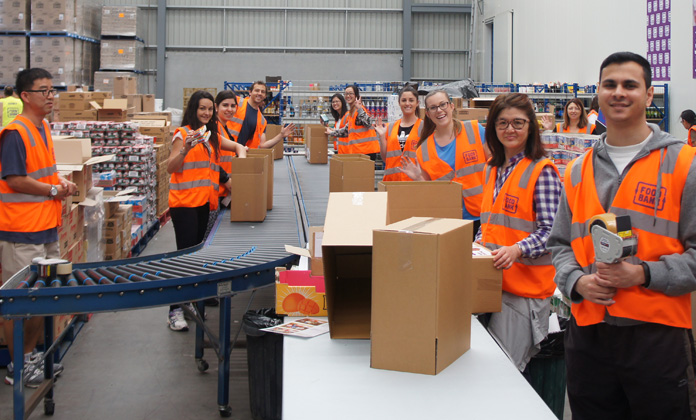Reserve Bank of Australia Annual Report – 2017 Community Engagement
Community engagement is important in ensuring that the Reserve Bank succeeds in promoting the public interest, which is a core value of the Bank. Staff in the Bank's Head Office and State Offices work to ensure that the Bank's role and actions are well understood by the community and that the Bank in turn understands the community's perspectives. The Bank supports academic research and education and also engages with the public through the Reserve Bank of Australia Museum.
Reserve Bank staff work to ensure that the Bank's role and actions are explained to the public, business and government, and that community perspectives, priorities and concerns in turn are understood by Bank staff. In addition to the specific details of community engagement set out in this chapter, many more individual engagements of Bank staff – from the Governor through to staff from all parts of the Bank – occur each week with different individuals and groups throughout the community. These range from the public speeches given by senior Bank staff, as discussed in the chapter on ‘Accountability and Communication’, to small private discussions.
As noted in the chapter on ‘Governance’, the Reserve Bank Board meets in state capitals on a regular basis. In the case of Adelaide, Brisbane, Melbourne and Perth, where the Reserve Bank has offices, the Board meeting is held in the Bank's office. A dinner with senior members of the local community is held in the evening following the Board meeting. These dinners, which are attended by political, business and public sector leaders, as well as representatives of the education, not-for-profit and other sectors, provide an opportunity for relationships between local communities and the Bank to be strengthened. A dinner with senior members of the Sydney community is held every two to three years with the same objective. In 2016/17, dinners were held in Sydney in September 2016 and in Melbourne in April 2017.
Reserve Bank of Australia Museum
The Reserve Bank's Museum houses a permanent collection of artefacts and hosts periodic exhibitions. It also offers regular talks and tours for visitors and students. Visitors can view the various types of money used before Federation through to the innovative next generation banknotes, including the new $5 banknote, which was launched in September 2016. Visitors can observe the evolution of the nation's identity as expressed through its banknotes and learn about the influential women and men depicted on them. They can also study the artwork used in banknote design, learn about how banknotes are made and discover their security features.
To mark the launch of the new $5 banknote, the museum added a display to its permanent collection entitled A New Vision for Banknotes. This display was designed to capture the innovative qualities of the new banknotes as well as the fact that these banknotes allow the vision-impaired community to recognise each denomination more easily by having a tactile feature, which was introduced for this series. The display showcases the new $5 banknote, its artistic design and production process. In addition, a large multi-touch screen enables visitors to explore the design elements and security features of the new banknote, along with historical and contextual information about the national stories that are depicted on the note. The screen enables additional information to be displayed and provides visitors with an interactive learning experience.
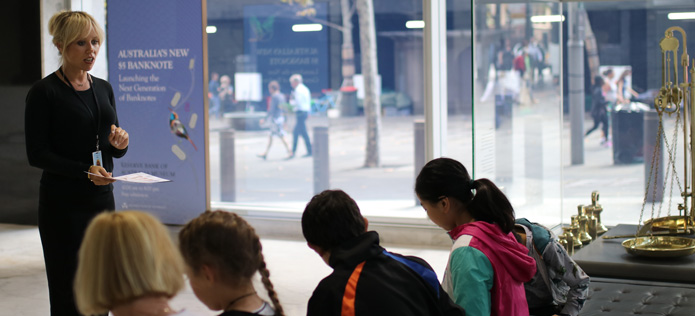
Following the release of the new banknote, a book was produced entitled Notable Australians. It documents the historical figures portrayed on each Australian banknote since portraits were introduced in the 1920s, and it reveals the gradual broadening of the identities included on the banknotes to be more inclusive of the range of men and women who have contributed to the nation. The book serves as a catalogue for the museum's collection and is an educational resource for students of history and design.
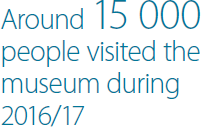
Given the ongoing commemoration of the centenary of World War I in the community, the museum has retained its temporary exhibition entitled Before Sunset: The Bank & World War I. The exhibition shows how World War I was associated with the emergence of central banking in Australia. The exhibition explains central bank functions, originally performed by a part of the Commonwealth Bank of Australia that later became the Reserve Bank, and showcases artefacts related to the Bank's involvement in the war, including financial documents and rare letters sent to the Governor of the day from the battlefields.
Around 15,000 people visited the museum during 2016/17, a slight decline from the previous year, with access restricted by building works. Nearly two-thirds of visitors were educational groups, spanning primary schools, secondary schools and universities. The number of secondary school students visiting the museum increased by around 15 per cent over the year, to account for nearly half of all visitors, with this increase reflecting the expansion of the Reserve Bank's public education program. Visiting groups can receive talks about the role of the Bank, the economy, the new banknotes or museum exhibits.
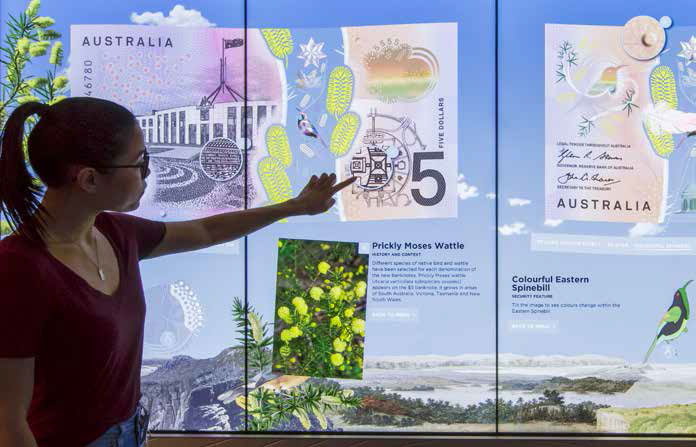
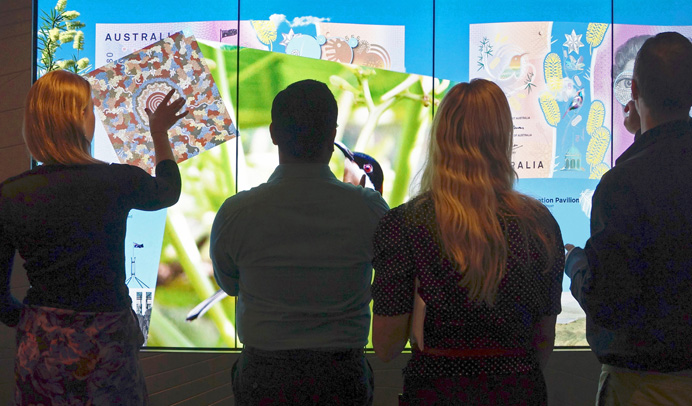
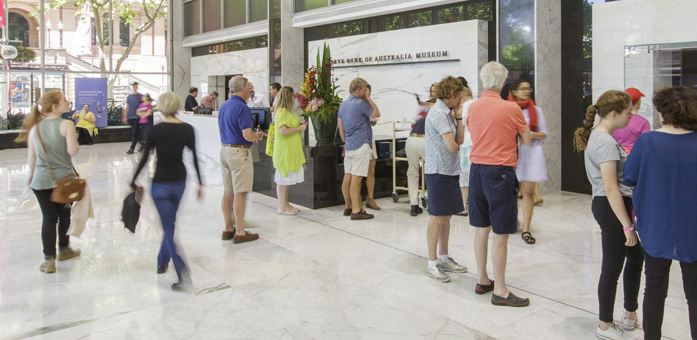
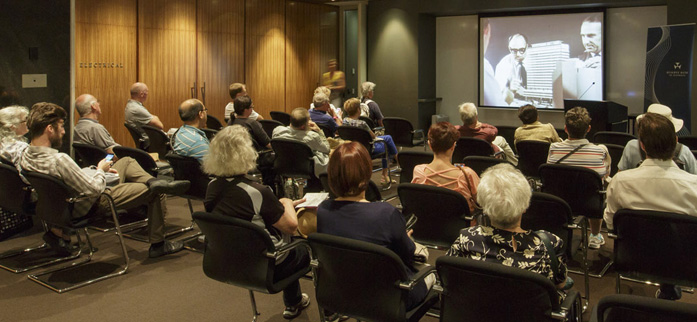
The Reserve Bank again participated in Sydney Open in 2016 – an event designed to give the public access to important or unique buildings – with over 1,400 visitors to the Bank's public foyer areas and attending talks in the museum about the architecture and design of the heritage-listed Head Office building. Smaller groups enjoyed access to select parts of the building (including, for the first time, the boardroom), where they learned about the central banking activities undertaken in these spaces. They also learned about their unique architecture and design features, which form part of the cultural legacy of former Governor HC Coombs.
Most of the information in the museum is depicted on the museum's website. Additional resources were added to the museum website in 2016/17, including an expansion of the existing online exhibition associated with World War I to mark the centenaries of key battles in which former Bank staff were involved. There was also an online exhibition to mark the centenary of the birth of Sidney Nolan – an artist with a significant connection to HC Coombs and whose work forms part of the Bank's archival collection.
Public Education
The Reserve Bank significantly expanded and formalised its approach to public education during the year in review, with the establishment of a dedicated Public Access & Education team to support the needs of educators and students and coordinate the efforts of staff across the Bank in the delivery of a public education program. The initial focus of the team is on supporting economics educators and students at secondary and tertiary level, a group identified as being in particular need.
The number of high school students studying economics in Year 12 has fallen by around 70 per cent over the past 25 years, based on data available for the major states. The share of high schools offering economics as a subject has also fallen significantly over this period, with the decrease being most pronounced in government schools. In addition, females have accounted for a declining share of high school economic students. This is resulting in a student base for economics that is diminishing in size and diversity. The Bank is aiming to help redress this by ensuring that students have a stronger appreciation of what economics is, its relevance and the career opportunities it provides.
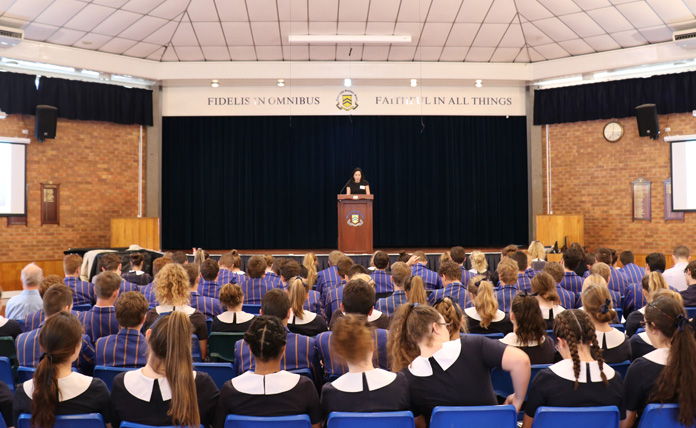
To that end, the Reserve Bank established an Educators Advisory Panel comprising external education experts to advise on the strategic direction of the Bank's public education program; this panel met for the first time in June 2017. The Bank also expanded the number and types of talks given to educators and students, ensuring that the content provided is aligned with curricula. As well as hosting many more talks to students and educators who visit the Bank's museum, talks were given across the country, with this outreach supported by staff in the Bank's State Offices as well as staff from Head Office. In addition, a program has commenced to visit schools and deliver talks in classrooms, helping to ensure equitable access to Bank resources.
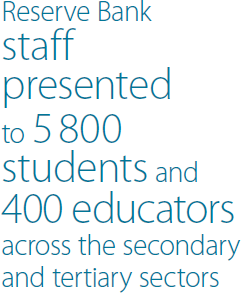
In June 2017, the Reserve Bank hosted a professional development day for economics teachers, inviting teachers from all states to attend a series of sessions related to Year 12 economics curricula. The sessions covered some of the most requested economic topic areas that relate to the Bank's responsibilities. The teachers were addressed by the Governor and Deputy Governor, with presentations given by senior staff responsible for each of the Bank's charter functions, along with a cross-section of Bank economists.
In the six months since the introduction of the public education program at the start of 2017, Reserve Bank staff have presented to 5,800 students and 400 educators across the secondary and tertiary sectors.
Assistance for Research and Education
The Reserve Bank sponsors Australian and international economic research in areas that are closely aligned with its primary responsibilities. This sponsorship includes financial support for conferences, workshops, data gathering, journals and special research projects, and encompasses areas of study such as macroeconomics, econometrics and finance. In addition, the Bank provides financial support for the activities of the Centre for Independent Studies and the Sydney Institute. It is a corporate member of the Lowy Institute for International Policy and a member organisation of the Committee for Economic Development of Australia (CEDA); the Bank's membership of CEDA includes an annual research contribution.
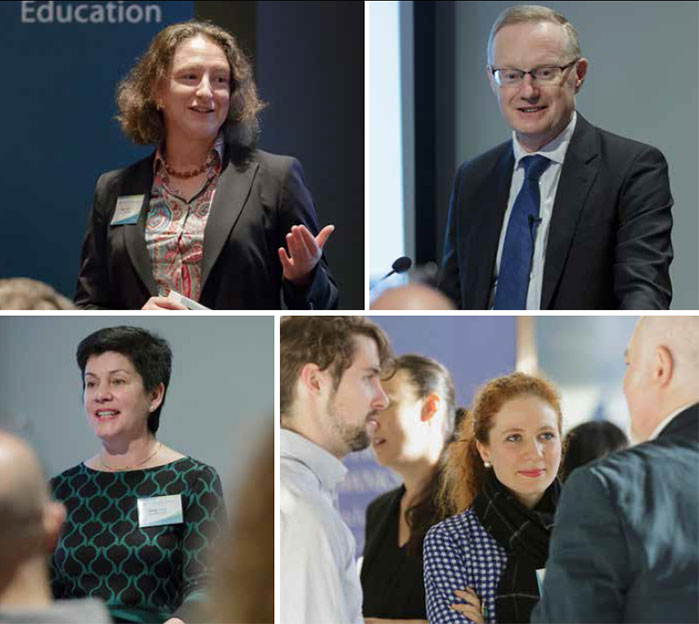
In 2016/17, the Reserve Bank continued its longstanding contribution towards the cost of a monthly survey of inflationary expectations undertaken by the Melbourne Institute of Applied Economic and Social Research at the University of Melbourne. The Bank also maintained its contribution towards a quarterly survey of union inflationary and wage expectations undertaken by the Australian Council of Trade Unions.
The Reserve Bank continued to provide financial support for the International Journal of Central Banking, the primary objectives of which are to disseminate first-class, policy-relevant and applied research on central banking and to promote communication among researchers both inside and outside central banks. In his position as Governor, Glenn Stevens AC was a member of The Bretton Woods Committee, whose programs and publications aim to promote economic growth, reduce poverty and maintain financial stability globally. The membership entailed a modest annual financial contribution.
Financial assistance to Australian universities each year includes contributions towards the cost of conferences on economics and closely related fields. In 2016/17, these conferences included: the Economic Society of Australia's Australian Conference of Economists, held in Sydney; the 22nd Melbourne Money and Finance Conference; the University of New South Wales 29th Australasian Finance & Banking Conference; the Paul Woolley Centre for the Study of Capital Market Dysfunctionality Conference 2016, hosted by the University of Technology Sydney; the 29th PhD Conference in Economics and Business held at the University of Western Australia; the Women in Economics Retreat, held in Bowral, organised by the Economic Society of Australia; the International Conference on Financial Cycles, Interconnectedness, Systemic Risk and Policy Options for Resilience, organised by the University of New South Wales; the Melbourne Institute Macroeconomic Policy Meetings; and the 2016 Workshop of the Australasian Macroeconomics Society, held at the University of Queensland. The Reserve Bank also supports the discussion of economic issues in the community by providing a venue for the Economic Society of Australia's Lunchtime Seminar and the Emerging Economist Series.
The Reserve Bank sponsored an essay competition across Australia, designed to engage and support undergraduate students interested in economics. The RBA/ESA Economics Competition was organised jointly with the Economic Society of Australia and the University of New South Wales Economics Society. In 2016, students were invited to discuss how an environment of low interest rates might affect conventional monetary policy transmission channels, and policy options in such an environment. The winning essay was written by Elizabeth Baldwin (University of Queensland), the runner-up was Shaun Ji-Thompson (University of Queensland), and the best essay from a first-year student was by Timothy Grey (University of Sydney). The Governor presented these students with prizes at a ceremony at the Bank in October 2016.
In conjunction with the Australian Prudential Regulation Authority (APRA), the Reserve Bank has continued to sponsor the Brian Gray Scholarship Program, initiated in 2002 in memory of a former senior officer of the Bank and APRA. Four scholarships were awarded under this program in 2017. The cost to the Bank of these scholarships in 2016/17 was $30,000.
The total value of support offered for research and education in 2016/17 was $294,229.
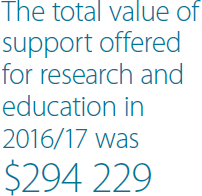
During the year in review, the Reserve Bank responded to over 200 research requests for information from its Archives. Researchers making such requests included academics, post-graduate students, authors, numismatists, philatelists, heritage consultants, genealogists and local history groups. The Archives contain a rich collection of records about the Bank's own activities as well as those of financial institutions in Australia that predate the creation of the central bank as a separate institution. There has been an increase in the number of requests relating to historical episodes of financial crisis, Britain's accession into the European Economic Community, Australia's engagement with Asia and the float of the Australian dollar. Following the launch of the new Australian banknote series, there was a significant increase in requests for information related to earlier banknote series, along with requests related to the Bank's rich photographic collection. A substantive long-term research request related to a local history group seeking a heritage listing for the Bank's old Note Printing Branch building in Fitzroy, Victoria, with research assistance by the Bank's archivists resulting in a successful application.
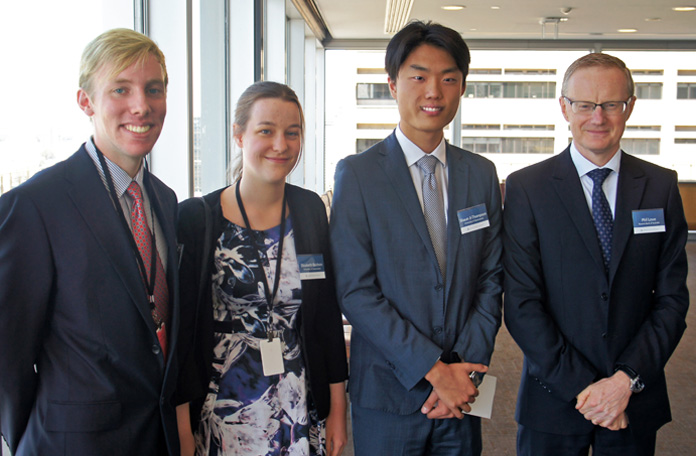
The program to digitise the Reserve Bank's most significant archival records continued during the year in review, with hundreds of thousands of records (including rare colonial ledgers and economic reports spanning the twentieth century) scanned and being made available electronically to researchers.
The Reserve Bank's Historian, Professor Selwyn Cornish of the Australian National University, is at an advanced stage of his research for the next volume of the official history of the Reserve Bank, which covers the period 1975–2000.
Charitable Activities
During 2016/17, the Reserve Bank made its 15th annual contribution of $50,000 to the Financial Markets Foundation for Children, which is chaired by the Governor. For many years, the Bank has donated a signed uncut banknote sheet to the ASX Thomson Reuters Charity Foundation for auction, which usually raises over $30,000. The Foundation includes the Financial Markets Foundation for Children in the distribution of auction proceeds. In July 2017, the Governor made his first address to the Anika Foundation's annual public event to raise funds to support research into adolescent depression and suicide; this was the 12th such event supported by the Bank.
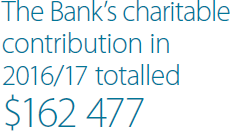
The Reserve Bank's corporate philanthropy program involves several initiatives, key among which involves dollar-matching staff payroll deductions (totalling $97,500 in 2016/17) organised by the Reserve Bank Benevolent Fund.
Reserve Bank staff participated in a number of volunteering activities in 2016/17 with The Smith Family, Foodbank and Oxfam Australia.
The Reserve Bank's contributions under all these initiatives in 2016/17 totalled $162,477. In addition, the Bank facilitates staff salary sacrificing under a Workplace Giving Program.
